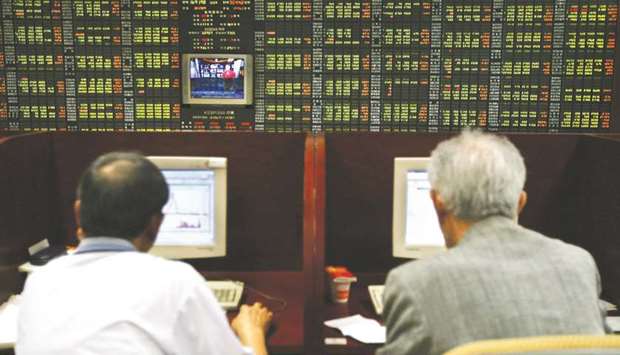The escalating war of words between President Donald Trump and North Korea’s Kim Jong-un has spurred demand for haven assets globally. In Seoul, bargain-seeking investors have turned bullish on consumer stocks.
Eight of top 10 gainers on the Kospi 200 Index since Trump’s “fire and fury” comment on August 8 include the cosmetics maker Cosmax, which soared 11.5% over the next three days, Hansae Co, a garments producer that rose 6.7%, and furniture maker Hyundai Livart Co, which rallied 5.1%. The index itself slid 3.4%.
While South Korean stocks suffered their worst week since February 2016 as Trump dialled up his warning to North Korea on threats to US allies, investors including Shinyoung Asset Management and Korea Investment Management said the sell-off is an opportunity to snap up consumer companies as President Moon Jae-in takes steps to stoke demand.
“The North Korean issue is a meaningless assumption, a short-term issue to be resolved,” said Jung Sang Jin, a fund manager at Korea Investment. “What’s really important is how the government’s policies impacts the market in the long run. The policies are aimed at stimulating consumer spending.”
The MSCI Korea Consumer Discretionary Index of 18 companies is at a three-month low even as consumer confidence remains buoyant amid Moon’s pledge to boost spending, exposing a gap between the economy and investor sentiment on the sector. Consumption improved in June and the momentum may continue in the second half, according to the finance ministry.
Measures taken by Moon to boost household incomes include a hike in minimum wages, an increase in taxes for companies and high-paid workers, and an expansion in coverage of national health insurance.
“We’re buying some consumer stocks that have been oversold,” Huh Nam-Kwon, chief executive officer at Shinyoung Asset Management, said in a phone interview without naming any companies. “The government is focusing on domestic consumption.”
Consumer stocks are also attracting investors rotating out of Korean technology shares, according to Korea Investment.
Samsung Electronics Co is down 7.4% so far this month after rallying to a record in July, while SK Hynix has slumped 16% from a 16-year high reached last month. Global funds sold a net 848bn won of Samsung shares in the three days through Friday, the most on the Kospi Index, and pulled a net 219bn won from SK Hynix.
The Kospi trades at 9.8 times of one-year forward earnings, compared with 14 times for the MSCI Asia Pacific Index. Per share earnings of the gauge’s members are projected to jump 77% over the next year, according to Bloomberg data.
“South Korean equities fell not because they are expensive, but because of country risk,” said Huh, a 30-year veteran of the nation’s equities. “I’ve seen people betting against country risk always becoming winners in the market.”
Meanwhile the North Korea standoff may be stoking volatility in assets from stocks to currencies, but the rates market is taking developments in its stride.
True, Bank of America’s MOVE Index – a gauge of volatility in the US Treasury market – has been rising, but it’s barely reached the highest in a few weeks.
As President Donald Trump and Kim Jong-un dial up their war of words, Treasury skews show traders may be hedging their short bond positions.
The subdued volatility is in stark contrast to equities and currencies, which have been rocked by last week’s escalating tensions. On Friday, Trump tweeted that military solutions were “locked and loaded” should North Korea act unwisely.
Here’s a look at how the gauges are playing out across the rates market – and elsewhere:
Even after last week’s increase, the MOVE Index has fallen 20 basis points this year, showing that investors have been largely unperturbed by bouts of geopolitical tensions.
The CBOE SPX Volatility Index, the equivalent gauge for equities, has reversed declines for 2017 thanks to last week’s surge.
Market participants used a small uptick in Treasury volatility before Thursday’s 30-year auction to position for a decline, while there was also interest in hedging earlier in that day’s session, according to Chicago traders.
The escalation in geopolitical risk caused the skew between payers and receivers on 10-year Treasury yields to fade to zero. At the start of the year, the skew was eight basis points amid optimism that surrounded Trump’s fiscal agenda.
It’s a similar story in German bunds, where volatility has also been limited. In an echo of the Treasury positioning, the value of call options for bunds has jumped as investors look to hedge against a more severe risk-off move. They had recently been selling calls and buying puts expiring in October, which covers the next European Central Bank meeting. However, this position has come under some pressure.
It’s not so calm in equities, where the biggest sell-off since May sparked an unprecedented rush for protection in the options market.
About 2.6mn puts and calls tied to the CBOE Volatility Index changed hands on Thursday, the most on record, as the VIX spiked 44% to close at the highest level since November 8.

Investors look at a stock index board in Seoul. In South Korea, bargain-seeking investors have turned bullish on consumer stocks.


